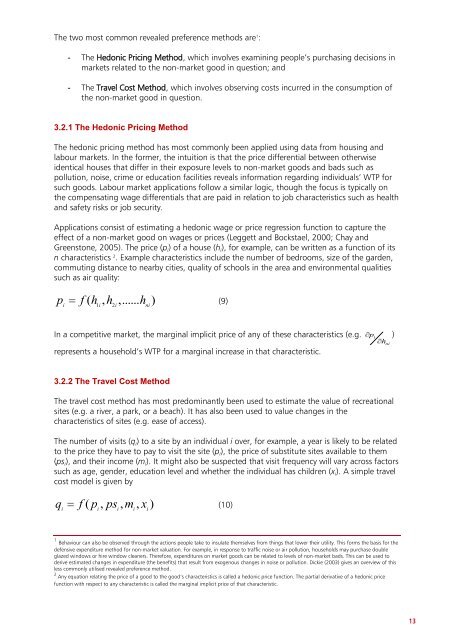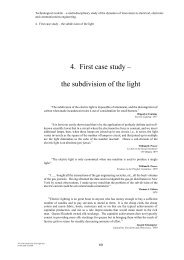Valuation Techniques for Social Cost-Benefit Analysis: - HM Treasury
Valuation Techniques for Social Cost-Benefit Analysis: - HM Treasury
Valuation Techniques for Social Cost-Benefit Analysis: - HM Treasury
You also want an ePaper? Increase the reach of your titles
YUMPU automatically turns print PDFs into web optimized ePapers that Google loves.
The two most common revealed preference methods are 1 :<br />
- The Hedonic Pricing Method, which involves examining people‘s purchasing decisions in<br />
markets related to the non-market good in question; and<br />
- The Travel <strong>Cost</strong> Method, which involves observing costs incurred in the consumption of<br />
the non-market good in question.<br />
3.2.1 The Hedonic Pricing Method<br />
The hedonic pricing method has most commonly been applied using data from housing and<br />
labour markets. In the <strong>for</strong>mer, the intuition is that the price differential between otherwise<br />
identical houses that differ in their exposure levels to non-market goods and bads such as<br />
pollution, noise, crime or education facilities reveals in<strong>for</strong>mation regarding individuals‘ WTP <strong>for</strong><br />
such goods. Labour market applications follow a similar logic, though the focus is typically on<br />
the compensating wage differentials that are paid in relation to job characteristics such as health<br />
and safety risks or job security.<br />
Applications consist of estimating a hedonic wage or price regression function to capture the<br />
effect of a non-market good on wages or prices (Leggett and Bockstael, 2000; Chay and<br />
Greenstone, 2005). The price (p i) of a house (h i), <strong>for</strong> example, can be written as a function of its<br />
n characteristics 2 . Example characteristics include the number of bedrooms, size of the garden,<br />
commuting distance to nearby cities, quality of schools in the area and environmental qualities<br />
such as air quality:<br />
p f h , h , ...... h )<br />
(9)<br />
i<br />
( 1i 2i<br />
ni<br />
In a competitive market, the marginal implicit price of any of these characteristics (e.g.<br />
represents a household‘s WTP <strong>for</strong> a marginal increase in that characteristic.<br />
3.2.2 The Travel <strong>Cost</strong> Method<br />
p )<br />
The travel cost method has most predominantly been used to estimate the value of recreational<br />
sites (e.g. a river, a park, or a beach). It has also been used to value changes in the<br />
characteristics of sites (e.g. ease of access).<br />
The number of visits (q i) to a site by an individual i over, <strong>for</strong> example, a year is likely to be related<br />
to the price they have to pay to visit the site (p i), the price of substitute sites available to them<br />
(ps i), and their income (m i). It might also be suspected that visit frequency will vary across factors<br />
such as age, gender, education level and whether the individual has children (x i). A simple travel<br />
cost model is given by<br />
q (10)<br />
i<br />
f ( p , ps , m , x )<br />
i i i i<br />
1 Behaviour can also be observed through the actions people take to insulate themselves from things that lower their utility. This <strong>for</strong>ms the basis <strong>for</strong> the<br />
defensive expenditure method <strong>for</strong> non-market valuation. For example, in response to traffic noise or air pollution, households may purchase double<br />
glazed windows or hire window cleaners. There<strong>for</strong>e, expenditures on market goods can be related to levels of non-market bads. This can be used to<br />
derive estimated changes in expenditure (the benefits) that result from exogenous changes in noise or pollution. Dickie (2003) gives an overview of this<br />
less commonly utilised revealed preference method.<br />
2 Any equation relating the price of a good to the good‘s characteristics is called a hedonic price function. The partial derivative of a hedonic price<br />
function with respect to any characteristic is called the marginal implicit price of that characteristic.<br />
i<br />
h<br />
ni<br />
13





![AIRTO [Professor Dr Brian Blunden] - HM Treasury](https://img.yumpu.com/15492848/1/184x260/airto-professor-dr-brian-blunden-hm-treasury.jpg?quality=85)










